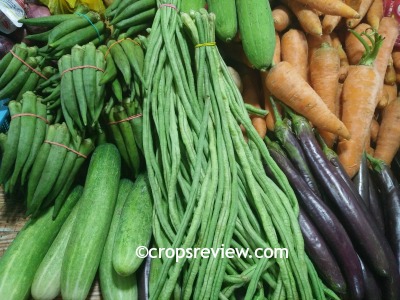First, what are vegetables and how many types of vegetables may there be?
For clarity, the term vegetables or vegetable crops is here meant to refer to a classification of agricultural crops under horticulture.
These crops are plants having edible parts that are used in culinary preparations either cooked or raw, as in salad recipes.

As to how many types, groupings, or classifications of vegetables are there, there can be no definitive answer.
Just like food recipes, there can be too many.
The classifications can vary depending on various considerations such as the taxonomic classifications of the crops (e.g., by family or by genus), the part of the plant that is edible (e.g., root vs. stem), and its stage of development (mature vs. young), their particular use in culinary preparation (for example, cooked vs. uncooked), the degree of detail that any distinction seeks to express, and who talks to who.
Clarification of Agronomic vs. Horticultural Crops
There is no definite demarcation line between agronomic and horticultural crops.
Both classifications can even apply to the same plant species due to different criteria of classification.
For example, taro or gabi (Colocasia esculenta) is an agronomic crop being grown mainly as a starchy root, tuber, and corm crop.
However, it is also a horticultural crop because it is largely utilized as a vegetable.
Another is corn or maize (Zea mays).
It is generally classified as an agronomic crop and listed under cereals because it is primarily grown for the harvesting of mature grains.
But it can become a horticultural and vegetable crop when, as in the case of sweet corn, it is grown for green corn.
Review of Some Types of Vegetables
According to Hill (1972), the vegetables can be grouped into three broad classifications based on their botanical parts that are edible and location with respect to the ground.
These are the earth vegetables, herbage vegetables, and fruit vegetables.
Earth vegetables are those in which the edible parts are below the ground including modified roots and stems.
Herbage vegetables are those with aboveground parts including stems, leaves, buds, and flowers.
Fruit vegetables are those in which the botanical fruits are usually cooked and rarely eaten raw except in salads.
He gave examples of crops under each of these three types of vegetables.
However, these types are only broad generalizations. It is noted also that he did not include seed vegetables.
HarperCollins and Lucy Peel (2004) grouped different vegetables into the following eight main types:
(1) salad vegetables,
(2) fruiting vegetables,
(3) squash vegetables,
(4) shooting vegetables,
(5) leafy vegetables,
(6) pod and seed vegetables,
(7) bulb vegetables,
and (8) root vegetables.
Within the household and circle of friends, these terms are likely easy to comprehend.
However, it is not clear on what basis are these groupings made.
Rimando (2004) simply defines vegetables as “crops usually grown for culinary purposes.”
He gave examples of vegetable crops under the following classifications:
(1) leafy vegetables,
(2) cole crop or crucifers,
(3) root and bulb crops,
(4) legumes or pulses,
(5) solanaceous vegetables,
and (6) cucurbits.
It is to be noted that these are a mixture of types of vegetables based on plant parts that are edible and in the botanical family.
Apparently, these are mere examples of vegetable groupings, an introduction to a more detailed lecture.
More Details
To put more details on Hill’s types of vegetables, six vegetable types are enumerated below.
The classifications are based on the botanical plant parts or organs that are edible and used in culinary preparation.
These can also be grouped into two main divisions: vegetables with edible vegetative parts (root, stem, and leafy vegetables) and those with edible reproductive parts (flower, fruit, and seed vegetables).
Based on their edible botanical parts, plants are grouped into the following types of vegetables:
1. Root Vegetables – plants that are sources of edible roots, mainly modified underground roots, e.g., beets and sweet potatoes.
These modified roots are either tuberous roots or fleshy roots.
2. Stem Vegetables – plants that are sources of edible botanical stems which are usually immature and succulent.
They can be divided further into those plants in which the edible plant structure consists mainly of aerial stems, e.g., bamboo shoots, and those with underground modified stems such as corms, tubers, bulbs, rhizomes, and stolons.
3. Leafy Vegetables – plants that are sources of edible leaves in various stages of development.
The leaves may be separate and fully expanded or, as in cabbage, form ahead.
It includes, in some species, succulent stems, e.g., sweet potato (camote tops).
4. Flower Vegetables – plants that are sources of edible flowers or inflorescences including, in some species, accessory parts like the stalk (pedicel or peduncle).
In cauliflower, it consists of the stalk and an immature inflorescence. But in squash, it is a mature flower.
5. Fruit Vegetables – plants which are sources of edible botanical fruits, either simple or compound, e.g., tomato and corn (maize).
6. Seed Vegetables – plants that are sources of edible botanical seeds, mostly under the family Leguminosae or Fabaceae (legumes), e.g., mung bean and pigeon pea.
LITERATURE CITED
- HILL A. 1972. Economic Botany. 2nd ed. New Delhi: Tata McGraw-Hill Pub. Co. Ltd. pp. 359-384.
- PEEL L. 2004. HarperCollins Practical Gardener: Kitchen Garden. New York, NY: HarperCollins Pub. Inc. 176 p.
- RIMANDO TJ. 2004. Lecture Syllabus: Crop Science 1. College of Agriculture, UPLB. P. 15.
